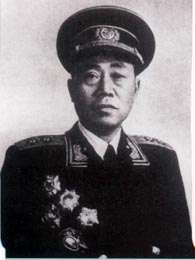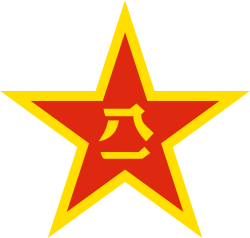Tao Yong
Tao Yong (Chinese: 陶勇; 21 January 1913 - 21 January 1967) was the Deputy Commander of the People's Liberation Army Navy (PLAN), also the Lieutenant General of the People's Liberation Army.
Tao Yong | |
|---|---|
 | |
| Personal details | |
| Political party | Communist Party of China |
| Spouse(s) | Zhu Lan |
Life Story
During the First Chinese Civil War
Tao Yong was born as Zhang Daoyong (Chinese: 张道庸) in a peasant family in Huoqiu County, Anhui Province on 21 January 1913. His father died when he was young and he had been a cowboy since he was seven. In February 1929, Zhang joined Communist Youth League and in April of the same year, he went to Shangcheng County, Henan Province to join the guerrilla and was appointed as the commander of the company of the Division 32 of the Eleventh Red Army. In the spring of 1931, Zhang was appointed as the leader of the security team of the security bureau in the Hubei, Henan and Anhui Area. In June of the same year, Zhang was appointed as the commander of the second company and also the deputy commander of the battalion commander of the first battalion of the Division 35, Regiment 35. In May 1932, Zhang joined the Communist Party of China and attended many anti-encirclement campaigns in the Eyuwan Soviet Area[1]。
Zhang followed the Fourth Red Army marching west and arrived in Sichang area, after which, he was appointed as the commander of the Second Battalion, Regiment 28, Division 10. Zhang led his battalion fight through many wars in the Chuangshan Soviet Area. In 1935, Zhang attended the Long March, and then he was appointed as the commander of the Training Regiment of the Ninth Red Army. In September 1936, Zhang followed the headquarters of the Fourth Red Army and crossed the Yellow River to join the fight as a member of the West- Road Army。In March 1937, after the failure of the West-Road Army, Zhang was arrested. Some organization of the Communist Party of China Central Committee rescued Zhang and helped him get back to Yan'an to study at Military and Political University of Resistance Against Japan.
During the Second Sino-Japanese War
After the outbreak of the Second Sino-Japanese War, Tao was appointed as the deputy commander of the first detachment of the Fourth Red Army, soon after which, he was appointed as the commander of the Fourth Regiment. In September 1939, Lu Sheng and Tao led the main force of the Fourth Regiment cross the Yangtze River and formed the detachment of Suzhou and Anhui Area, which created a guerrilla base of the area between Yangzhou and Tianchang County, Anhui Province.[2] Chen Yi changed Tao's name into Tao Yong. In July 1940, Tao was appointed as the commander of the third troop of the headquarters of the New Fourth Army and took part in Huangqiao Battle.
In January 1941, after the Southern Anhui Incident, the New Fourth Army was reorganized and Tao was appointed as the commander of the third bridge of the first regiment. In March 1942, Tao was appointed as the division commander of the Fourth Army of the military region of the middle Suzhou area, after which, they participated in anti-Japanese battles in Qing County.[3] In 1944, Tao took part in Cheqiao Battle. At the end of the same year, Tao led his division cross the Yangtze River and was appointed as the commander and political commissar of the third column of the military region of Suzhou and Zhejiang area. In 1945, Tao participated in the Tianmushan Battle.[4]
During the Second Chinese Civil War
In November 1945, Tao led his division leave Northern Suzhou area and reorganized his division into the Eighth Colum of the Field Army. Tao was the commander of the Eighth Colum and led his column attack Gaoyou and forced Japanese armies to give in. In June 1946, Tao was appointed as the deputy commander of the First Regiment of the Field Army. Tao then participated the battle in middle Suzhou and the defending war in Lianshui. in September 1946, Tao led his regiment go to Southern part of Shandong Province to take part in the Lunan Battle. With the help with other regiments, they annihilated the first column and the twenty-six regiment of the National Revolutionary Army. They soon attacked Zaozhuang County, annihilating Regiment 51 and capture more than 7700 enemies and their commander Zhou Yuying.[5]
In January 1947, the first regiment was reorganized into the fourth regiment of the Field Army of Eastern China and Tao was appointed as their commander while Wang Jicheng was appointed as the political commissar, leading the tenth, eleventh and twelfth regiment, amounting to more than 30,000 soldiers.[6] In the end of February, the Fourth Column took part in Laiwu Battle and annihilated the Li Xianzhou Group of the National Revolutionary Army. At the beginning of April, Tao led his regiment to the middle part of Shandong Province. After more than one month's fighting, they annihilated the 74th regiment of the National Revolutionary Army in Menglianggu Area, which was called the Menglianggu Battle. After three days' battle, they finally annihilated the 74th regiment. In the end of June, Tao led his regiment to fight in the Southern part of Shandong Province. In August of the same year, he led the eleventh and twelfth regiment go to the Southwestern part of Shandong Province and joined the West Troop. In November of the same year, they took part in the sabotage battle in Longhai Road and killed more than 3700 cavalry enemies in Guanting County.
In June 1948, Tao participated in the Yudong Battle, annihilating the Qv Shounian's troop. In September, they took part in the Jinan Battle. In the November of the same year, they participated in the Huaihai Battle, in the beginning of which, Tao joined the Huang Baitao's troop, after which, he joined the Surrounding-Du Yuming's troop and captured Du Yuming alive successfully.[7] In February 1949, the Fourth Column was renamed as the 23rd Army of the People's Liberation Army and Tao was appointed as the commander while Lu Sheng was appointed as the political commissar, leading 67th, 68th and 69th regiments.[8] On the 21st of April, the 23rd Army took part in the Crossing-River Battle, breaking the National Revolutionary Army's defense between Zhenjiang and Jiangyin Area, cutting Huning Railway and Ninghang Road. In May of the same year, Tao led his regiments to attack Hangzhou, soon after which, they participated in the Shanghai Battle.
After the Establishment of the People's Republic of China
In October 1950, Tao was appointed as the Deputy Commander of the Ninth Troop of the People's Volunteer Army and took part in the Korean war. He conducted the Ninth Troop to participate the battle in Changjing Lake. In 1951, Tao took part in the fifth battle in the Korean War, after which, he temporarily acted as the commander and political commissioner, winning the first class flag medal, and liberation and independence medal in the North Korea. In November 1952, Tao was appointed as the commander of the Navy Force of the East China Military Area Command, conducting many navy battles against the National Army of the Republic of China. In 1955, Tao was appointed as the commander of the East China Sea Flea, in succession to Yuan Yelie, awarded as the Lieutenant General of the People's Liberation Army. Tao won himself the first class Eight-One Medal, Independence and Liberation Medal and the first class Liberation Medal. Tao was then appointed as the Deputy Commander of the Navy Force. In November 1963, Tao was also appointed as the Deputy Commander of the Nanjing Military Region[9]。
Tao Yong was killed in the Cultural Revolution. On 21 January 1967, Tao was found dead in the water well in the back garden of the guesthouse of the East Sea Fleet. As for the reason why Tao died stays misery until now. Soon after Tao's death, the party committed of Navy had classified him as "traitor" and "committing suicide for fear of punishment"[10];In September of the same year, Zhu Lan, Tao's wife, was also killed. In 1977, the Central Military Commission redressed the grievances done to Tao Yong and his wife.
References
- 星火燎原编辑部 (2007). 中国人民解放军将帅名录. 第一卷. 北京: 解放军出版社. p. 433. ISBN 7-5065-5031-8.
- 中国新四军和华中抗日根据地研究会 (2012). 新四军在华中. 北京: 军事科学出版社. p. 46. ISBN 7-80237-518-5.
- 《战将陶勇》编委会 (2013). 战将陶勇. 上海: 上海人民出版社. p. 9. ISBN 978-7-208-11234-6.
- 张明金; 刘立勤 (2010). 中国人民解放军历史上的200个军区. 北京: 解放军文艺出版社. p. 180. ISBN 978-7-5033-2252-5.
- 张明金; 赵功德 (2006). 中国人民解放军历史上的70个军. 解放军文艺出版社. p. 272. ISBN 978-7-5033-1940-2.
- 南京军区《第三野战军战史》编辑室 (1999). 中国人民解放军第三野战军战史. 北京: 解放军出版社. p. 90. ISBN 978-7-5065-5397-1.
- 欧阳青 (2011). 大授衔:1955共和国将帅授衔档案. 北京: 长城出版社. p. 512. ISBN 978-7-5483-0058-8.
- 《中国人民解放军军史》编写组 (2010). 中国人民解放军军史:第三卷. 军事科学出版社. p. 325. ISBN 978-7-80237-381-5.
- "陶勇". 中国共产党新闻网. Retrieved 2010-03-01.
- 高戈主编 (1988). 历史内幕纪实 上. 兰州: 甘肃人民出版社. pp. 236–237. ISBN 7-226-00399-6.
